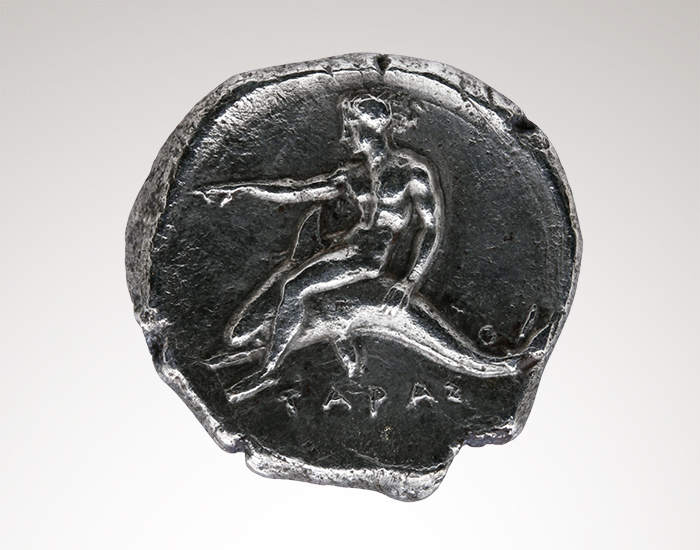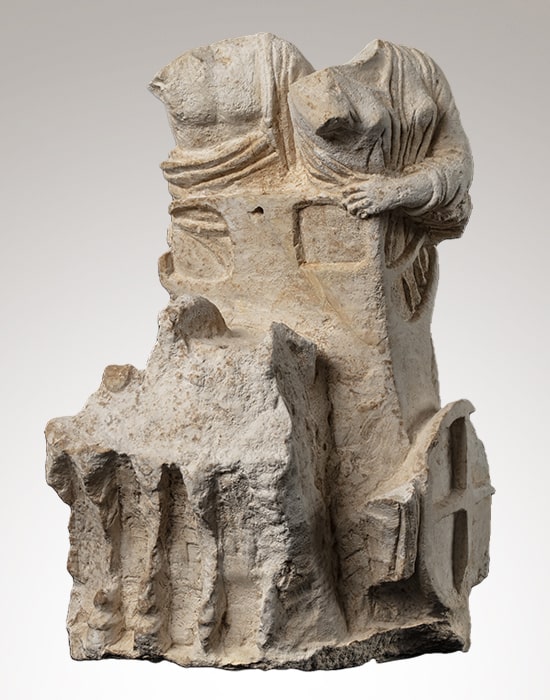Taranto from its foundation to its conquest by the Romans
ITINERARIES AND COLLECTIONS
Taranto in the Archaic period:
Myths, archaeology and history of the Spartan colony
According to tradition, Taranto, the only Spartan colony in Magna Graecia, was founded in 706 B.C. The origin of the colonization is said to be the revolt of the Parthenians (literally “sons of virgins”), born from illegitimate unions during the wars between Sparta and Messenia, who were eager to enjoy full political rights. In order to quell the rebellion, it was decided —with the approval of the oracle of Delphi— to send the insurgents to the West where they could settle, under the supervision of their leader, Falanto. The Spartan colony of Taras took its name from a river and from the hero, son of Poseidon and the nymph Satyria, depicted, on the coins of the city mint, while straddling a dolphin. Archaeology has substantially confirmed the era of the foundation revealing an interruption in the occupation of the indigenous settlement in the area of the Old City of Taranto around the end of the 8th century B.C. Thus the prophecy of the Delphi Apollo seems to have been fulfilled. As Falanto and his companions were about to leave, Apollo entrusted them with the task of being the “scourge” of the Iapigi, the indigenous peoples of Apulia. However, there is archaeological evidence of episodes of integration and peaceful coexistence between the two ethnic groups.
Coin minted in Taranto, 365-355 B.C.

Dimension of the sacred: forms of worship and sanctuaries in Taranto and in its chora
Our knowledge of the sanctuaries and forms of worship of the Greek Taranto is very incomplete and based mostly on material documents whose context of discovery is not always known. The few architectural remains of sacred buildings were brought to light in the area of the acropolis (Old Town), namely the Doric temple of Piazza Castello, among the first stone buildings of the Greek West (early 6th century B.C.), and a second temple underneath the Convent of San Domenico.
A characteristic phenomenon of Taranto is the presence of extensive deposits of votive figurines not only in the sacred areas but also in the burial grounds: pits filled with votive figurines —often depicting male characters in the act of drinking as they lie in a semi-recumbent position on beds, or riding on the backs of real or fantastic animals— testifying to the existence of forms of rituals connected to funerary practices.
From a more limited number of deposits have come items that provide evidence of the continuing religion-based relationship between Taranto and Sparta, evident above all starting from the middle of the 4th century B.C. This is the case of terracotta votive tablets (pinakes) and pairs of amphorae used for rituals linked to the cult of the Dioscuri, the twin sons of Zeus who were venerated especially in Sparta. The sanctuaries found in the chora (the territory directly controlled by the colony) include the sanctuary of Saturo, on the south-east coast of Taranto: the sacred area of the so-called acropolis, probably dedicated to Athena, and the Sanctuary of the Spring, whose main divinity is very likely Aphrodite Basilis (the Queen), also present in Sparta and on the acropolis of Taranto.
A recumbent reclining on a kline (couch), end of the 6th Century B.C.

The city of the dead:
the necropolis of Taranto from classical antiquity to the Hellenistic period
The historian Polybius tells us about how the people of Taranto, seeking to know about the future of their city addressed the oracle of Apollo. The response of the oracle was quite unique: the city would be prosperous if its inhabitants would adapt to living with “the more numerous”, that is to say with the dead. This was a way of explaining the presence of burial grounds not only outside the city, as was usual in the classical world, but also within the city.
This situation actually came about during the fifth century B.C. as a result of the expansion of the urban area and the construction of the walls. Throughout the archaic period, the areas to be used as burial grounds had instead been kept distinct from public and residential spaces, with the tombs being mostly interred in graves dug in the tuffaceous rock and covered with large slabs. In the 6th century B.C. the practice of burying the dead in a sarcophagus was widely adopted; but in the last decades of the century, small groups of men, of aristocratic status and having in common the fact that they had been competitive athletes, would be buried together in monumental tombs placed in a chamber. Starting from the mid-5th century B.C., due to the democratic evolution of the political system and the adoption of laws that limited luxury in the funerary sphere, the use of individual burials in a sarcophagus with only few funerary objects became common practice.
The chamber tombs became fashionable again between the late 4th century B.C. and the mid-Hellenistic period, even after the definitive conquest of Taranto by the Romans (209 B.C.): family hypogeums became common, with funerary beds and furnishings made of richly painted stone, whose presence was indicated by monumentalized grave markers which in some cases took the form of little temples (naiskoi).
Part of a pediment in Carparo stone depicting Persephone kidnapped by Hades, second half of the 4th Century B.C.






